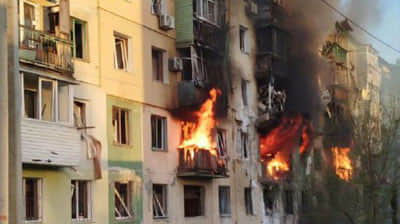What will happen if the enemy strikes the Chernobyl nuclear power plant? Forecast
Olena Barsukova
28 February 2022
During the war against Ukraine, the Russian invaders seized the Chernobyl nuclear power plant (NPP), which is currently not damaged.
Scientists at "Chornobyl Insight’’ discussed possible consequences of a military strike on the Chernobyl nuclear power plant.
The "Shelter’’ is an old "Sarcophagus’’ built in 1986-1987, and is gradually collapsing. However, the building itself is now intact.
A New Safe Confinement (NSC) was built over the "Shelter’’. The NSC is an arch capable of withstanding tornadoes, heavy snow, static voltage and shock load.
The arch was built to allow the dismantling of unstable structures of the "Shelter’’.
The NPP building itself was erected taking into account special requirements.
In particular, the buildings of any nuclear power plant must withstand the maximum possible earthquake and hurricane conditions of the given location.
In addition, some of the nuclear power plant's facilities were built to withstand a possible plane crash and the impact of an air shock wave.
During Russia's aggression from the northern borders, the use of military aircraft will be the biggest risk for Chernobyl.
The researchers considered the following hypothetical options:
- A strike on the Chernobyl nuclear power plant is carried out by aircraft;
- A volume-detonating air bomb is used;
- The energy release of the explosion equals 1000 kg of trinitrotoluene (TNT).
The experts analysed the consequences of the impact of the air shock wave on the buildings and structures of the Chernobyl industrial site.
The main danger of a bomb blast near the Chernobyl NPT is that a significant part of the radioactivity is in the form of dust inside the ‘’Shelter’’, i.e. it is located under the ‘’Shelter’’ and under the NSC.
The breach of the NSC integrity will lead to the release of radioactive dust into the environment.
When the Chernobyl catastrophe occurred, the fuel melted and radioactive lava flowed down, melting the building materials and mixing with them.
This lava flow stopped for a long time. It froze and cooled, forming something like very hard (as it is molten sand), and very heavy (as there is uranium, lead and other heavy metals) minerals.
It is very difficult to extract this substance where it is now.
- The main danger is radioactive dust and water that dissolved it.
It should be understood that during the Chernobyl catastrophe the reactor was burning.
The combustion temperature was very high, and radioactive substances were released into the air at altitudes above 10 km for several decades.
"If any bomb is dropped on the Chernobyl NPP, such a fire is simply impossible. There is nothing left to burn.
But the destruction of the NSC in the event of an explosion is highly probable. And it can lead to the release of highly radioactive dust into the environment, " experts say.
In this case, we should expect the exposure of personnel in the territory of the Chernobyl NPP and personnel in the exclusion zone in the city of Chernobyl to this radioactive dust.
Therefore, this radioactive dust will remain in the exclusion zone itself.
"Imagine that you throw a stone into the dust - and the dust flies up. Something like this can happen in the event of a Chernobyl explosion," – experts say.
To be less afraid, they advise looking at the numbers:
According to expert estimates, radioactive substances from 40,000 to 120,000 Curies may be released into the environment.
This is hundreds of thousands of times less than was released in the 1986 Chernobyl accident (50 million Curies).
- The first people to be affected will be those nearby, as the open air within a radius of several kilometres will be irradiated.
According to expert estimates, the radiation dose to Chernobyl personnel in the open air will reach 1-2 Sv (Sievert).
This is a million times higher than permissible levels in the event of a radiation accident.
- Irradiation of the human body in such doses for a short period of time (several hours) will lead to the manifestation of radiation syndrome.
Irradiation index of 1 Sv is considered a maximum dose that can cause radiation sickness.
This dose will lead to dysfunction of human tissues and organs (intestinal cramps, headache, apathy, nausea).
Of 1000 people irradiated with a dose of more than 1 Sv, two are expected to die.
People living and working in Chernobyl 16 km away from the Chernobyl NPP will receive about 100 mSv (Millisievert) - a relatively safe figure.
There is no change in blood composition and no other severe effects of radiation in a body irradiated in such doses.
In reality, this dose may be much lower.
- The main danger for Ukrainians is that these radionuclides will begin to migrate through food chains and end up in the Pripyat river, and eventually into the Dnieper.
Kyiv Reservoir, used to supply drinking water, will be under threat of intense radioactive contamination.
To prevent such a scenario, it will be necessary to build dams on the waterway, use filters and invent new ways to purify water.
- A danger lies in this radioactive water that will contaminate plants, which will eventually contaminate agricultural land.
If this happens, it will be necessary to listen to the advice of scientists.
Before growing crops along the Pripyat and the northern part of the Dnipro river, there will be a need to check the soil for radioactivity in sanatoriums and specialized institutes.
The movement of radioactive substances on land through plant-human, plant-animal-human, soil-plant-animal-human trophic chains is so fast that even radionuclides, which "live" for a relatively short time, can accumulate in the human body in significant quantities.
This is why it is extremely important not to let them get inside the body.
In addition, it is unknown what is currently happening with used nuclear fuel storage facilities in the Chernobyl Exclusion Zone. There are two of these facilities on the territory of the 10-kilometer zone of the Chernobyl NPP.
"We hope that all of the above will remain just a hypothetical scenario. Let’s remember that this is just a scenario, a possible course of events with a set of assumptions.
Why do you need to know this? To be ready," scientists emphasise.





